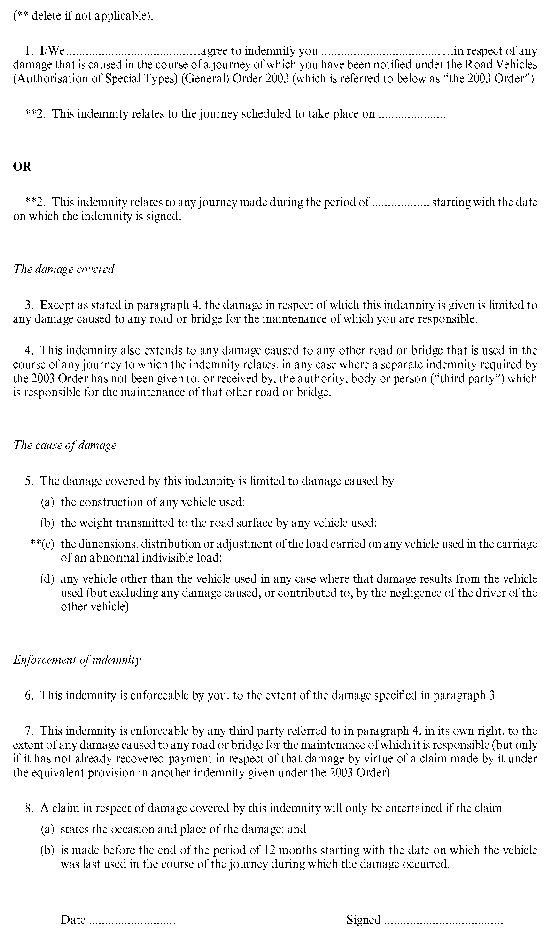Article 17(1), 35(2) and 40(2)
SCHEDULE 9ROAD AND BRIDGE AUTHORITIES
PART 1NOTICES
1.—(1) In this Schedule “the authority” means—
(a)in relation to a road, the highway authority for that road;
(b)in relation to a bridge vested in a transport authority, that authority;
(c)in relation to any other bridge, the authority, body or person in whom the bridge is vested.
(2) For the purposes of sub-paragraph (1)(b)—
“transport authority” means the authority, body or person having the control or management of a transport undertaking; and
“transport undertaking” means a railway, tramway, dock, harbour, pier, canal or inland navigation undertaking which carries on its activities, or some of its activities, under statutory authority.
2.—(1) A notice must be given to—
(a)the authority for each road on which the vehicle or vehicle-combination is to be used; and
(b)the authority for each bridge on which the vehicle or vehicle-combination is to be used.
(2) In the case of any vehicle or vehicle-combination which has a gross weight exceeding 80,000 kilograms, the notice must be given so that it is received by each authority before the beginning of the period of five days which ends immediately before the date of use.
(3) In any other case, the notice must be given so that it is received by each authority before the beginning of the period of two days which ends immediately before the date of use.
(4) An authority may accept a shorter period of notice in any case.
(5) “Date of use”, in relation to any vehicle or vehicle-combination to which a notice relates, means the date on which the use on roads of the vehicle or vehicle-combination is to begin.
3. The notice must be in a form acceptable to the authority to which it is to be given and should be agreed by both parties.
4.—(1) The notice(1) must contain—
(a)a list of all the authorities to which notice is given;
(b)details of the user of the vehicle or vehicle-combination, stating—
address,
telephone number,
fax number,
email address (if any),
user’s licence number,
user’s reference number;
(c)details of the intended use of the vehicle or vehicle-combination, stating—
point of departure,
point of destination,
time, date and route of journey,
particulars of any load (including description and profile of load);
(d)details of the vehicle or vehicle-combination used, stating—
registration number of any motor vehicle,
type of vehicle or vehicles,
overall length of the vehicle or vehicle-combination (including length of any front and rear projection),
overall length of each single rigid unit included in a Part 2 vehicle-combination (including length of any front and rear projection),
overall width (including width of any lateral projection),
maximum height,
gross weight or gross train weight,
number of wheels per axle,
all axle weights,
all axle spacings.
(2) The authority may accept fewer details in any case.
(3) In sub-paragraph (2)(d), “single rigid unit” in relation to a Part 2 vehicle-combination has the meaning given by article 12(4).
5.—(1) This paragraph applies in relation to the use on roads of a Part 2 vehicle-combination that includes an abnormal indivisible load vehicle that is a trailer.
(2) Where it is found impracticable to use any vehicle specified in a notice given under this Part, a vehicle of a similar type may be substituted if notice of the substitution is given to every authority to which the earlier notice was given.
PART 2INDEMNITIES
6.—(1) An indemnity under this Part of this Schedule may be given in relation to—
(a)a particular journey; or
(b)in relation to any journey made during a period of one year or less, starting with the date on which the indemnity is given.
(2) Paragraph 6(1)(b) applies only if the authority to which the indemnity is to be given agrees to it in writing.
7. An indemnity is given in accordance with this Part of this Schedule if it is given in the following form.
Applications can be made through esdal.nationalhighways.co.uk or a standard application form can be obtained on the National Highways website or by calling the Abnormal Loads team on 0300 470 3004.
